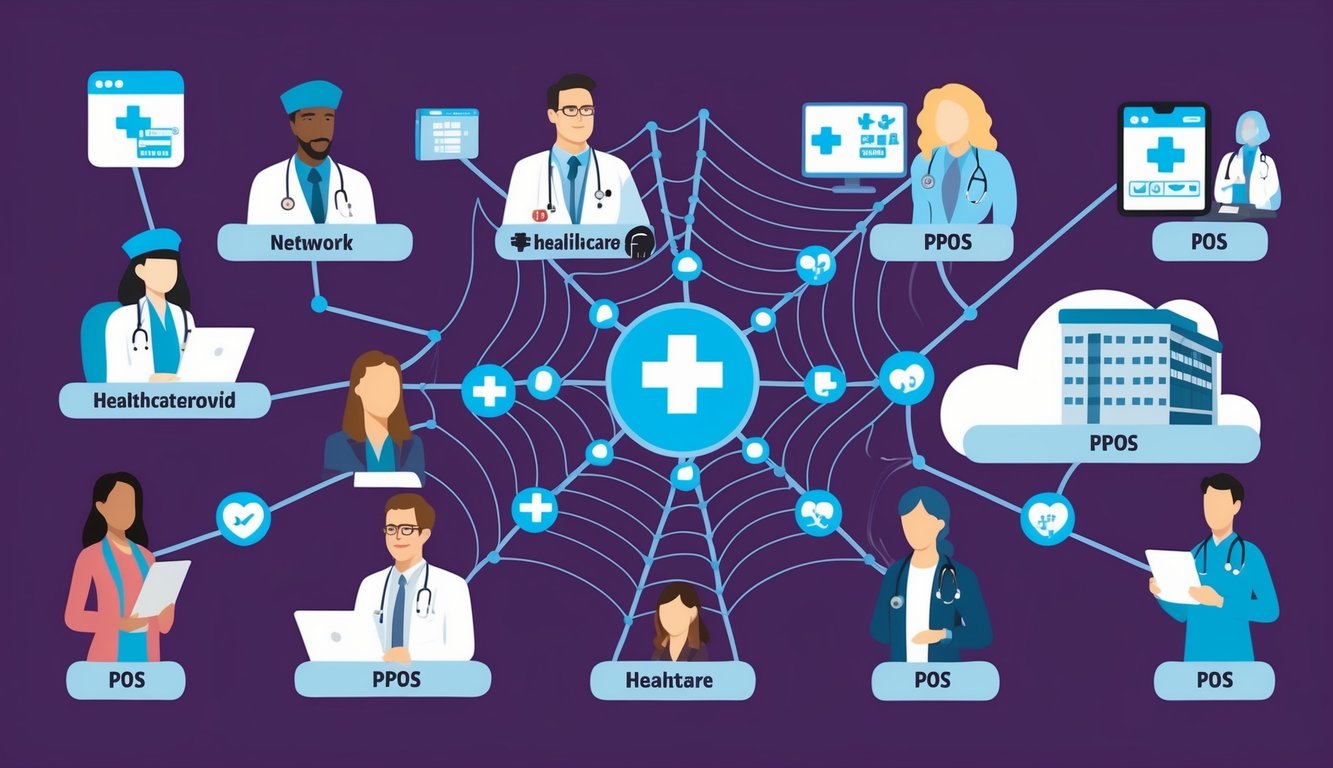Understanding PPO Networks
PPO networks provide you with flexibility in choosing healthcare providers while balancing cost and coverage.
This section explores the key components of Preferred Provider Organizations, variations in their plans, and the structure of the network.
Fundamentals of Preferred Provider Organizations
A Preferred Provider Organization (PPO) is a type of managed care plan.
It allows you to receive services from both in-network and out-of-network providers.
In-network providers often offer discounted rates, making healthcare more affordable.
With a PPO plan, you do not need a referral to see a specialist, enhancing convenience.
You can visit any licensed healthcare provider, but out-of-network services typically come with higher coinsurance and deductibles.
This structure grants you the freedom to choose your healthcare path while navigating your costs.
Variations in PPO Plans
PPO plans may differ in terms of premiums, deductibles, and out-of-pocket maximums.
You might encounter variations such as Exclusive Provider Organizations (EPOs), which limit coverage to in-network providers, except in emergencies.
Some PPO plans offer lower premiums but may require higher copayments or deductibles for out-of-network services.
Understanding these variations helps you select a plan that matches your healthcare needs and financial situation.
Your choice should align with how often you seek out-of-network care or specialty services, considering potential costs.
PPO Network Structure and Provider Types
A PPO network comprises various healthcare providers, including hospitals, specialists, and general practitioners.
Preferred providers sign agreements with the PPO to deliver services at negotiated rates.
When you choose to use in-network providers, you benefit from lower costs.
Conversely, using out-of-network providers entails higher expenses, often involving a percentage-based coinsurance arrangement.
You should evaluate your healthcare needs against the available providers within the network.
This evaluation ensures you optimize both access and affordability while utilizing your PPO health plan effectively.
Comparing Health Insurance Plan Types

When evaluating different health insurance plan types, it’s essential to understand their unique features and how they align with your healthcare needs.
Each plan, whether it’s a PPO, HMO, or POS, has distinct characteristics that impact your treatment options and out-of-pocket costs.
PPO Versus HMO and EPO
Preferred Provider Organizations (PPOs) offer more flexibility compared to Health Maintenance Organizations (HMOs) and Exclusive Provider Organizations (EPOs).
With a PPO, you can see any healthcare provider, including specialists, without needing a referral.
This is advantageous if you prefer direct access to a wider range of services.
In contrast, HMOs generally require you to select a primary care physician (PCP) who coordinates your healthcare and provides referrals for specialists.
EPOs, like HMOs, cover only in-network care except for emergencies.
This can limit your options but often leads to lower premiums.
Point of Service (POS) Plans
Point of Service (POS) plans combine features of both HMOs and PPOs.
Like an HMO, you choose a primary care physician who will manage your care and provide referrals.
However, POS plans also allow you the freedom to see out-of-network providers at a higher cost, similar to a PPO.
Choosing a POS plan can provide a balance between cost and flexibility.
You benefit from lower out-of-pocket expenses for in-network services while retaining the option to seek care outside the network when necessary.
Flexibility and Accessibility Differences
Flexibility is a key difference among these health insurance plan types.
PPOs are known for their broad network and no need for referrals, giving you the most freedom to choose providers.
This flexibility can be particularly important if you have specific doctors you prefer.
HMOs, while often more economical, come with restrictions that limit your choices to a defined network.
This can affect accessibility to certain specialists or treatments.
EPOs also limit you to an exclusive network, similar to HMOs but typically offer fewer restrictions.
Financial Aspects of PPO Health Plans

PPO health plans offer flexibility but come with specific financial considerations.
Understanding how deductibles, out-of-pocket costs, and coverage options work is crucial in managing your healthcare expenses effectively.
Understanding Deductibles and Coinsurance
In a PPO plan, a deductible is the amount you pay out-of-pocket for medical services before your insurance kicks in.
For example, if your deductible is $1,000, you must cover that amount before your insurer starts sharing costs.
Once you meet your deductible, you typically share costs through coinsurance.
This is a percentage of the costs you pay along with what your insurance covers.
For instance, if your coinsurance is 20%, you pay 20% of the medical bill while your plan pays the remaining 80%.
Understanding these terms helps you budget for medical expenses efficiently.
Out-of-Pocket Costs and Premiums
Out-of-pocket costs include deductibles, coinsurance, and copayments, which are fixed amounts you pay for specific services.
For instance, you might pay a $30 copayment for a doctor’s visit after meeting your deductible.
In addition to these costs, you’ll pay a monthly premium for your PPO plan.
This amount varies based on the plan and your specific needs, often ranging from $300 to $700 per month for individual coverage.
Keeping track of these expenses can help you avoid unexpected bills.
Coverage for Out-of-Network Care
One of the appealing features of a PPO is its coverage for out-of-network care.
While in-network services usually cost less, you still have the option to see out-of-network providers.
Be aware that you might face higher deductibles and coinsurance rates when doing so.
It’s essential to check your policy for specifics on out-of-network coverage.
This ensures you understand your financial responsibilities before seeking care outside the network.
You may find it beneficial to find a balance between flexibility and cost-saving by choosing in-network providers whenever possible.
PPOs and Healthcare Providers

In a PPO (Preferred Provider Organization) network, participants have greater flexibility in choosing their healthcare providers.
This section discusses the important roles various providers play and the way referrals and access to facilities are structured within these plans.
Role of Primary Care Providers in PPOs
Your primary care provider (PCP) is often your first point of contact for healthcare services.
In a PPO network, you have the freedom to select any healthcare provider, but choosing a PCP who participates in the network can reduce your out-of-pocket costs.
A PCP, which may be a primary care physician or doctor, coordinates your overall healthcare.
They provide routine check-ups, preventive services, and manage chronic conditions.
This relationship ensures your medical history is well-documented, which aids in effective treatment.
Having a trusted PCP helps you navigate the healthcare system efficiently.
Additionally, your provider can guide you to specialists if the need arises, optimizing your healthcare experience.
Referrals and Specialist Consultations
In a PPO, referrals to see a specialist are not always necessary, unlike other plans such as HMOs.
This allows you to access specialized care directly, facilitating quicker treatments.
When you do seek a referral, your PCP typically recommends specialists who are within the PPO network.
Utilizing in-network specialists minimizes your financial responsibility for healthcare services.
If you choose an out-of-network specialist, be aware that you may face higher costs.
Understanding your plan’s nuances regarding referrals is critical for managing expenses while receiving quality care.
Hospital and Urgent Care Access
One of the advantages of a PPO is ease of access to hospitals and urgent care facilities.
You have the flexibility to go to any hospital, whether in-network or out-of-network.
In-network hospitals usually offer lower copays and coinsurance, which can significantly reduce your healthcare costs.
Familiarizing yourself with nearby in-network hospitals can be beneficial during emergencies.
Urgent care centers are also commonly included within PPO networks.
These centers provide essential healthcare services for non-life-threatening conditions, typically at a fraction of the cost of emergency room visits, making them a smart choice for quick care.
Regulatory and Preventive Health Services under PPOs

PPO networks play a crucial role in facilitating access to various healthcare services, particularly preventive and emergency care.
Understanding how regulations like the Affordable Care Act enhance these benefits is essential for enrollees looking to maximize their health coverage.
The Affordable Care Act’s Impact
The Affordable Care Act (ACA) significantly improved access to preventive services through PPO networks.
Under the ACA, many preventive services, such as vaccinations, cancer screenings, and wellness check-ups, are covered without cost-sharing when provided by in-network providers.
This means you can obtain essential health screenings and preventive care while minimizing out-of-pocket expenses.
Additionally, insurers cannot impose annual or lifetime limits on these essential health benefits, providing critical protection against unexpected healthcare costs.
PPO plans align with ACA provisions by promoting preventive care, ultimately leading to better health outcomes and lower overall costs for members.
You benefit from improved access to care that can identify potential health issues early, encouraging proactive management and treatment.
Coverage of Preventive and Emergency Services
PPOs are designed to offer broad coverage for both preventive and emergency health services.
Preventive services are often delivered at no cost to you, especially when using network providers.
This includes routine check-ups, immunizations, and screenings.
In the event of an emergency, PPOs allow you to access care without prior authorization, even if you visit out-of-network facilities.
You generally pay a higher cost for out-of-network services, but the flexibility provided by PPOs is beneficial during urgent situations, ensuring you receive timely care.
Additionally, prescription drugs and outpatient care are commonly included within these plans, making it easier for you to manage chronic conditions and maintain overall health.
Understanding your plan’s specific coverage is essential to optimize your healthcare utilization.
Frequently Asked Questions

Understanding the intricacies of PPO networks is essential for optimizing your healthcare choices.
The following FAQs address key aspects you should consider when navigating PPO plans, including comparisons with other insurance types, provider access, and selection criteria.
What are the main differences between PPO and HMO insurance plans?
PPO plans offer more flexibility in choosing providers, allowing you to see out-of-network doctors at a higher cost.
In contrast, HMO plans typically require you to choose a primary care physician and receive referrals for specialists, limiting your options but often providing lower premiums.
How can individuals determine which providers are in a given PPO network?
You can check the PPO network directory, usually available on the insurance provider’s website.
Additionally, customer service representatives can assist you in identifying in-network providers based on your location and healthcare needs.
What are the benefits of being enrolled in a PPO network for healthcare services?
Enrolling in a PPO network grants you broader access to a range of healthcare providers and specialists without needing referrals.
This flexibility can lead to quicker medical attention, which is crucial for timely healthcare management.
How does one review and compare PPO networks?
To review and compare PPO networks, assess the number of participating providers, the specialties available, and the networks’ overall reputation.
User reviews and ratings can provide insights into patient satisfaction levels.
What factors should be considered when choosing a PPO network?
When choosing a PPO network, you should consider several factors.
These include the range of covered services, premium costs, deductibles, and copayments.
Additionally, make sure to evaluate the accessibility of healthcare providers and facilities within the network.
How does the coverage area of a PPO network affect patient choice?
The coverage area directly influences your choices.
It determines which providers and hospitals are available to you.
A broader coverage area typically offers more options, especially for travel or relocation.
Meanwhile, a limited area may restrict your choices to nearby facilities.






